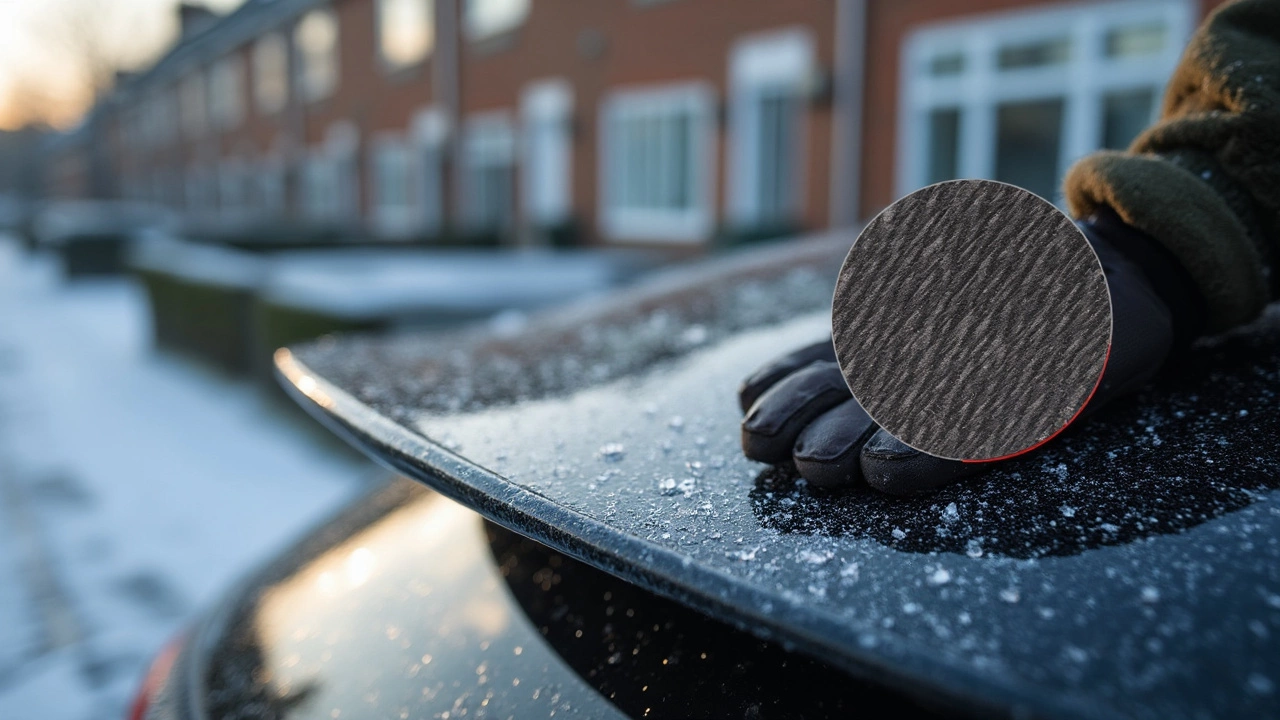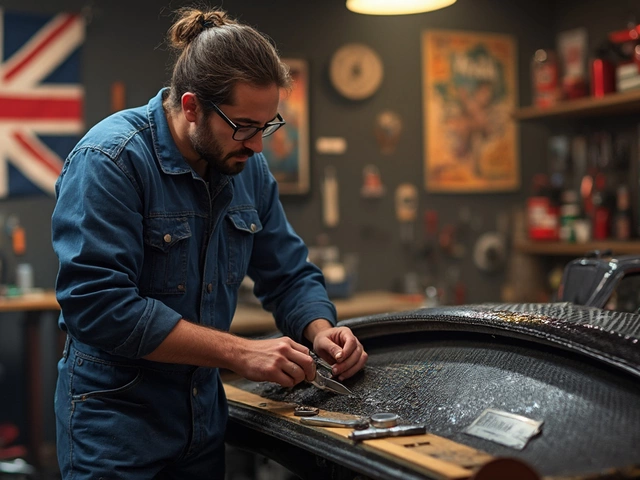Ever walked outside on a freezing morning and wondered if your sweet carbon fiber spoiler would hold up or snap like a brittle icicle? You’re not alone. Lots of car owners are curious if cold weather means trouble for those sleek add-ons.
Forget wild guesses. The way carbon fiber reacts to chilly temps isn’t just some car forum rumor. It comes down to what carbon fiber really is and how it deals with sudden temperature swings. You probably want straight answers—can it really crack when the weather gets cold, or is that just hype?
Here’s what matters: spoilers aren’t just for looks. If carbon fiber fails, it can get expensive quick. So, understanding the warning signs and learning a couple of practical tips could keep your ride looking killer—and save you a headache once winter hits.
- What Carbon Fiber Really Is
- Why Temperature Changes Matter
- Does Cold Make Carbon Fiber Crack?
- Risks Unique to Carbon Fiber Spoilers
- Signs and Prevention Tips
- When to Worry and When Not To
What Carbon Fiber Really Is
When you hear the term carbon fiber, think of a bunch of thin threads, each one made from carbon atoms all lined up, and then bundled together. These threads get woven into a fabric. That fabric isn’t strong by itself—it needs a partner: resin. It’s this combo—carbon fiber fabric soaked and set with resin—that ends up as the solid, tough panels used in your car spoiler.
The big deal about carbon fiber? It’s crazy strong for its weight. We’re talking about something that’s stiffer and stronger than steel but weighs about two-thirds less. That’s why race cars, high-end bikes, and even planes use it. Here’s a simple comparison to lay it out:
| Material | Strength-to-Weight | Common Use |
|---|---|---|
| Steel | Good | Chassis, body structure |
| Aluminum | Better | Wheels, panels |
| Carbon Fiber | Excellent | Spoilers, hoods, supercars |
But not all carbon fiber gear is created equally. The quality depends on things like how the fibers are laid out, what type of resin is used, and even the curing process. Cheap knock-offs might look the part but could be much weaker than the real deal found on high-performance rides.
For carbon fiber spoilers, manufacturers usually go for a mix of strength, durability, and lightness. They’re made to handle air pressure at high speeds, some bumps, and—most important for us—changing weather conditions. The resin in the mix helps seal out moisture and holds those fibers in place, giving the finished spoiler its signature glossy look. If you see a chipped or yellowed spoiler, that’s usually the resin starting to fail, not the fibers themselves.
Bottom line: carbon fiber is a tough, high-tech sandwich of woven threads and glue, purpose-built to be light and strong. That’s why it’s all over the car world—and why people want it on their spoilers.
Why Temperature Changes Matter
Here’s where things get real for your carbon fiber spoiler. Materials expand and contract as the temperature swings from hot to cold or back again. But not all stuff changes size at the same rate. For carbon fiber, what you really have is a sandwich: strong strands of carbon mixed with a resin, usually epoxy. Each of those two main ingredients reacts a bit differently to temperature drops.
When it gets cold, the carbon fiber itself doesn’t move much, but the resin can shrink more. That small mismatch creates some tension inside the spoiler. Now, a well-made carbon fiber spoiler is designed to handle these stresses. But over time, and with enough big drops on the thermometer, that tension can add up, especially if there are small dings or flaws from the factory or from road grime.
You might think metal spoilers would have it worse, but it’s actually the sudden changes—like blasting the heater in your garage after a cold spell—that stress out carbon fiber parts because they’re not great with rapid, extreme changes. Everyday cold, though, is usually no problem if your spoiler is made right.
- Cracking Risks: Not super common for quality carbon fiber parts, but cheap resins or sloppy work make cracks a lot more likely, especially in really cold climates.
- Brittleness: Resin can get stiffer in cold weather, so a strong hit—like a chunk of salt from a snowplow—might do more damage than in summer.
For the stat lovers, check this out:
| Material | Expansion Rate (per °C) |
|---|---|
| Carbon Fiber | ~0.2 x 10-6 |
| Epoxy Resin | ~50 x 10-6 |
Those numbers just show how much more the resin can move in the cold compared to the carbon fiber itself. If your carbon fiber spoiler handles every temp swing you throw at it, you can thank that engineering.
Does Cold Make Carbon Fiber Crack?
The short version? Carbon fiber itself doesn’t just crack from cold weather alone. This stuff isn’t like cheap plastic that turns into glass at the first sign of frost. In fact, carbon fiber is used in some of the coldest places—think of airplanes flying at crazy altitudes, or racing bikes used in freezing European winters.
Here’s the real science: carbon fiber on its own is incredibly strong and doesn’t get brittle in the cold. The problem, if there is one, comes from the resin that holds the carbon fibers together (that’s the glue-like stuff you don’t really see). If that resin is cheap or not cured right during manufacturing, it can shrink or pull apart a bit when it gets really cold.
But how cold are we talking? For most quality carbon fiber spoilers, issues only show up when temps drop far below what you’ll ever see on a typical city street. Here’s a quick comparison to give you a better idea:
| Material | Temp Where It Gets Brittle (°F) |
|---|---|
| Carbon Fiber (with good resin) | -40 |
| Plastic Spoilers | -10 |
| Aluminum | -70 |
So, unless you’re living in Antarctica, your carbon fiber spoiler is probably safe from winter cracks. The real risks only happen if the spoiler was built with poor-quality resin, or if it’s super old and took a lot of hits over the years—think curb damage, dings, or bad repairs.
If you really want to play it safe, avoid sudden impacts or pressure on the spoiler when it’s below freezing. Ice can make any material, even tough ones, more likely to chip if you whack it hard with a snow brush or scrape it with something metal.

Risks Unique to Carbon Fiber Spoilers
Not all car parts get the same punishment in the cold, but your carbon fiber spoiler faces some unique issues. Here’s the real kicker—carbon fiber by itself doesn’t mind the chill. The problem usually comes down to the resin holding the fibers together. Most spoilers use an epoxy resin, and that stuff can get a little more brittle once temps drop below freezing.
Mix in the constant flexing from wind when you’re driving, plus any bumps or potholes you hit, and you’ve got a little more stress happening at the surface. Sometimes rapid temperature swings—like leaving a heated garage and then parking in subzero weather—can mess with the bond between the resin and the carbon fiber layers. Over time, this can lead to tiny cracks. These cracks are rarely huge right away, but left unchecked, they can spread.
It’s not just about the material. Installation plays a huge role. If your carbon fiber spoiler is incorrectly mounted, the added pressure points can make cracking in the cold a bigger problem. Paint and clear coat can also get brittle and flake off in the same conditions, leaving the carbon fiber exposed to road salt or water, which speeds up damage.
Key reasons why cold weather risks increase for carbon fiber spoilers:
- Brittle resin: Resin used in molding can crack faster when it’s cold.
- Incorrect installation: Tight bolts or uneven pressure ramps up the risk of cracks, especially with sudden temperature changes.
- Surface damage: Road salt and debris are tougher on exposed or weakened areas in winter.
- Poor quality spoilers: Cheap materials or shortcuts during manufacturing can lead to more cold-weather issues.
Back in 2023, a survey of aftermarket car part shops in Michigan showed that 18% of all returns for carbon fiber spoilers were due to visible microcracks after a cold snap. That says a lot about why you need to pay attention—both to how your spoiler was made and how you treat it when winter comes.
Watching how your carbon fiber spoiler is installed and giving it a quick glance for chips, cracks, or peeling before and after cold spells can save you big. It’s not indestructible, but with the right care, your spoiler can definitely survive the winter.
Signs and Prevention Tips
It doesn’t take a pro to spot when something’s wrong with your carbon fiber spoiler. Just keep your eyes open for a few classic red flags that could mean it’s having a hard time coping with cold weather or just everyday stress.
- Hairline cracks or spiderwebbing: These tiny cracks might creep in, especially around mounting points or sharp corners. They're not always obvious, but you can catch them early if you look closely.
- White or cloudy spots: Sometimes cold snaps mess with the resin that holds the fibers together, leading to changes in color or appearance. That weird spot isn’t just dirt—it could be a warning sign.
- Delamination: If you notice the layers of the spoiler starting to separate or bubble up, this can spell trouble. Cold temps can help those issues show up faster.
- Strange noises: Any new rattling or creaking? That can mean there’s a structural issue—way more serious than just a cosmetic problem.
Here’s a smart move: check your spoiler every few weeks during winter, especially after big temperature drops or visits to the car wash. Freezing water can make tiny cracks worse.
“Carbon fiber itself won’t suddenly shatter in the cold, but resin shrinkage and stress from fast temperature swings can speed up surface cracks if you’re not careful,” says Mark Green, composite engineer at Midwest AeroTech.
Prevention doesn’t have to be a chore. Try these simple tips to help your carbon fiber spoiler last longer through frosty months:
- Wax your spoiler: A good wax job helps keep moisture out of the resin.
- Steer clear of automatic car washes: The harsh chemicals and brushes can wear down the protective topcoat and expose weak spots.
- Hand-dry after washing: Don’t leave water to freeze on the surface.
- Park indoors if possible: Avoid exposing your carbon fiber to repeated freeze-thaw cycles.
- Tighten mounting points: A loose fit leads to flexing, which makes cracks worse.
Just to put things in perspective, check out how temperature swings impact composite materials in this simple table:
| Material | Temp Tolerance (°C) | Crack Risk in Cold |
|---|---|---|
| Carbon Fiber (Automotive Grade) | -40 to +90 | Low, if proper resin used |
| Fiberglass | -20 to +70 | Moderate |
| ABS Plastic | -15 to +50 | High |
Remember, a little attention goes a long way. Watch for the warning signs, keep your carbon fiber spoiler clean and dry, and you’ll sidestep cracking drama all winter long.
When to Worry and When Not To
The truth is, most of the time you don't have to freak out about your carbon fiber spoiler every time the temperature drops. If your spoiler is made with quality resin and installed right, those winter mornings won’t crack it just because it’s cold. High-end carbon fiber parts are built to handle a lot more than a frosty night or even a rough snowstorm.
But there are situations where you should be on alert. If your car’s spoiler came cheap, there’s a bigger chance the resin is low quality or the manufacturing was sloppy. That makes it way more likely to get brittle and crack when the weather changes fast between warm and freezing. Ultraviolet (UV) rays and moisture can also mess with the resin over time, especially if you park outside all year and let old chips or nicks go unfixed.
- Visible Cracks: Thin lines, spiders, or white marks on your spoiler? Could be the start of a bigger split, especially after freezing rain or rapid temperature swings.
- Strange Noises: If your spoiler starts creaking or rattling in the cold, something may be shifting where it connects to your car.
- Loose Fit: Wobbly spoilers move around more and that extra flexing in cold temps isn’t good news.
- Surface Bubbles or Fogging: Water or air getting under a poorly sealed resin layer will damage even tough carbon fiber over time.
Keep in mind though, nearly all premium carbon fiber spoilers used in performance cars are tested for all sorts of rough conditions, cold included. Brands that cut corners are rare, but that’s where the risk sits.
| Good Quality Spoiler | Cheap Spoiler |
|---|---|
| Resin resists cracking below -30°C/-22°F | Resin can crack above -10°C/14°F if made poorly |
| Well-sealed from moisture | May allow water to seep in, expand when frozen |
| UV treated | No protection against sun or weathering |
So, bottom line: if you check your spoiler a couple times a year, fix small chips fast, and don’t beat it up on ice, your carbon fiber hardware will take winter in stride. The real danger is letting small problems or cheap parts slide until they snap. If everything looks solid and you're not seeing the warning signs above, most likely your spoiler will outlast another winter without a hitch.




